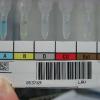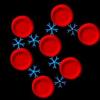Reputation Activity
-
 Dansket got a reaction from swede in Donor Unit ABO/Rh confirmatory test result entry in Meditech
Dansket got a reaction from swede in Donor Unit ABO/Rh confirmatory test result entry in Meditech
US standards require transfusion services to perform serological testing on red cells obtained from an integral donor tubing segment from cellular blood components to confirm the correctness of the ABO/Rh container label prior to transfusion.
Units labeled Rh Negative must be tested with anti-D, but not Rh Positive units. Units labeled A, B or AB are tested with anti-A and anti-B and units labeled group O may be tested with anti-A,B only.
Meditech standardly allows for a single test to document the above serological test results. This test is automatically ordered when a cellular blood component is logged into the system. For example, when an OPOS unit is logged, user is presented with a test requiring results entry for anti-A, anti-B, anti-A,B and anti-D despite a serological testing protocol using anti-A,B only. If an ABPOS unit is logged, again, 4 tests (anti-A, anti-B, anti-A,B and anti-D) must be resulted in some manner even though unit was tested with anti-A and anti-B only.
This has been bugging me for years, but I finally figured out a way to configure Meditech so that if an OPOS unit is logged, only anti-A,B is reflexed; if an ABPOS unit is logged, only anti-A and anti-B are reflexed.
To accomplish this requires creation of 3 different Order Groups, a T type test with Auto Result, a PRE type calculation using the keyword "bsp bt" and profile tests with T tests configured with anti-A, anti-B, anti-A,B and anti-D according to your testing protocols.
If you are an interested Meditech user (I'm currently using C/S ver 5.66), please private email me via PathLabTalk.
-

-
 Dansket reacted to tbostock in Use of C/T ratio for surgery
Dansket reacted to tbostock in Use of C/T ratio for surgery
See if there are any ways you can streamline your processes in the Blood Bank to not have so many set up for OR. We changed our SSBOS requirements; almost all procedures now get only a Type and Screen. Since we do electronic crossmatches now, we only crossmatch units ahead for patients with antibodies.
-
 Dansket reacted to Malcolm Needs in Ruling out Kell with Heterozygous cells?
Dansket reacted to Malcolm Needs in Ruling out Kell with Heterozygous cells?
I am going to be REALLY unpopular here, but I'm going to say it anyway (because I am a pedant)!!!!!!!!!!!
Antigens CANNOT be either heterozygous or homozygous; only genes can be heterozygous or homozygous.
An antigen can be described as either showing homozygous expression, or heterozygous expression.
That having been said, is a red cell sample that types as K+k- phenotypically, genotypically K/K or K/Ko, or even K/k, with a mutation within the Kell gene that prevents the k antigen being expressed and detected with all anti-k grouping reagents (just in case anyone doesn't believe me - we had one!).
That's got that off my chest.
Now then, there is NO doubt that there are some anti-K's around that only react with K+k- red cells (dosage), but they are fairly rare, however, how many people use antibody screening red cells that are K+k-? I doubt if there are any. Therefore, we are all ruling out anti-K using red cells with apparent K antigen heterozygous expression on every single sample that (apparently) has no atypical alloantibodies present. Am I wrong about this?
It follows, therefore, that, over the years, there MUST have been occasions when a patient with a very weak anti-K (one that is only detected using red cells that are apparently showing homozygous expression) and who has been transfused with K+ blood (do the maths). As far as I know, there are no papers within the literature that report a case of either a delayed or an acute transfusion reaction as a result of this. Yes, this may cause the anti-K to become stronger (and, hence, be detectable using an apparent heterozygous red cell sample showing K+k+ expression), but then, if this happens, you give K- blood.
So, my considered answer is that you can exclude using K+k+ red cells.
I shall now go and lie down!!!!!!!!!!!!!
-
 Dansket got a reaction from Malcolm Needs in Standards requiring retypes on new patients
Dansket got a reaction from Malcolm Needs in Standards requiring retypes on new patients
Transfusion Services should be very concerned about how to avoid WBIT (wrong blood in tube). There are two approaches to this problem, 1)one approach is to focus on testing errors and the other is 2)to focus on specimen collection errors. Repeat testing of the same blood sample (by the same person or different persons) will only detect testing errors. Testing a second blood sample (preferably collected at a different time and by a different phlebotomist) will also detect specimen collection errors, i.e., blood samples collected from wrong patient or blood samples labeled with wrong patient demographics.
-
 Dansket got a reaction from Michaele in Hampshire Controls T12 Temp Check
Dansket got a reaction from Michaele in Hampshire Controls T12 Temp Check
Have used model TC-3 for years without complaint. Cardinal Health sells a Blood Bank Thermometer catalog# CHBB1000 that is the same as TC-12.
-
 Dansket reacted to tbostock in Least Incompatible units
Dansket reacted to tbostock in Least Incompatible units
I agree with David. I dropped the term "least incompatible" a long time ago. It gives the physician a false sense of security. They have done studies that a 1+ incompatible unit will do a patient no more or less harm than a 2+ incompatible unit. In vitro grading/results do not correlate what will or will not cause harm in the patient.
I know of some labs that use the term "serologically incompatible" when it's just the warm auto activity and all underlying alloantibodies were ruled out. This is more realistic than "least incompatible".
At my place we just call them all incompatible and have the MD sign a release, whether or not the allos have been ruled out. We like putting a healthy fear out there so they watch the patient more closely.
-
 Dansket reacted to Joanne P. Scannell in Positive Autocontrol in gel, negative DAT
Dansket reacted to Joanne P. Scannell in Positive Autocontrol in gel, negative DAT
I composed an answer to this yesterday and must have gotten 'sideswiped' before I posted it!
Anyway, here's what I have to add to this conversation ...
You cannot compare gel to tube testing. Aside from the 'sensitivity' issue (DAT could be positive in gel, negative in tube), gel has a totally different premise that needs to be taken into consideration.
Gel: Slippery RBCs will make it all the way to the bottom of the gel column during a given period of time at a given centrifugal force. Tube: Cells must be agglutinated. 1. Therefore, gel results are affected not only by coating of RBCs with antibodies, but also coating (roughening) with just about anything (proteins, medications). In addition, changes in shape (e.g. sickling, acanthrocytosis, fragmentation) will cause a slower migration to the bottom.
2. You cannot expect an auto control to give the same results as a DAT because the autocontrol has plasma in it. (It's like all ladies are women but not all women are ladies.) Certain properties of the plasma will affect this downward migration (e.g. artifact, fibrin, TP ratio leading to rouleaux, cold agglutinins).
3. You cannot even expect the same 'DAT grade' with an auto vs DAT. The autocontrol contains the same enhancement medium as the tests. The presence of an enhancement medium will, ummm, enhance the antigen-antibody reaction.
Suggestion: Don't mix your media. If Auto Control is positive in gel, don't bother running DAT with tube method; run it using same method as the Auto Control (gel) and be sure to include a 'negative' control using a buffer card with patient's cells.
If the buffer control is positive: You cannot determine if DAT is pos or neg because the 'positive result' may be due to steric interferrence rather than 'coated with antibody'; check hemo smear for sickling, acanthrocytes, etc. If the gel DAT is positive and the control is negative, your patient cells have a positive DAT. If the gel DAT is negative, the positive auto could be a result of plasma abnormalities, check protein analysis, cold agglutin, etc. Hope I haven't overstayed my welcome ...
-
 Dansket reacted to goodchild in irradiated blood for NICU babies?
Dansket reacted to goodchild in irradiated blood for NICU babies?
Agreed. We provide irradiated products to all NICU patients. The primary bag is irradiated by the supplier. We assign the primary bag to one neonate and provide aliquots until transfusions are no longer needed or the bag is depleted. In times of great demand we'll share primary bags between multiple neonates. We haven't had to wash a unit for years.
-
 Dansket got a reaction from goodchild in Do you use NP, TNP or QNS to override a blood type in Meditech
Dansket got a reaction from goodchild in Do you use NP, TNP or QNS to override a blood type in Meditech
Phil,
I'm in a very small facility staffed with generalists who have limited problem-solving skills with computers and Blood Bank. I feel that a BBK computer system should work very hard for me by limiting what the user can do. Meditech repeatedly sabotages my efforts!.
Dan
-
 Dansket got a reaction from Abdulhameed Al-Attas in Antibody Problem, Mysterious
Dansket got a reaction from Abdulhameed Al-Attas in Antibody Problem, Mysterious
Anti-Complement in your antiglobulin reagent.
-
 Dansket reacted to Dr. Pepper in New patients: shoud BB check diagnosis?
Dansket reacted to Dr. Pepper in New patients: shoud BB check diagnosis?
Ultimately, it's the responsibility of the ordering physician to request the appropriate component. It is fine for us to be a backup, with problem patient files and computer warnings that a patient may have special needs, and hospital transfusion policies listing "standard order" indications for certain components, and to question odd requests. I don't think we should be the first line of defense, however. If your lab has the resources and backing (like a stable of 24/7 knowledgeable pathologists) to dig deeply into every blood request prospectively and ensure that the component is totally appropriate for the patient, you are blessed. I don't think that describes a lot of us, though.
-
 Dansket reacted to L106 in New patients: shoud BB check diagnosis?
Dansket reacted to L106 in New patients: shoud BB check diagnosis?
Very good points, John. It is not uncommon to get crossmatches on "irradiated-warranted" patients with ER or admitting diagnoses such as "weakness" or "anemia" or "bleeding."
I'm all for calling the doc if something raises your suspicion, but I don't think it is appropriate to make it the laboratorian's responsibility to check diagnoses.
Donna
-
 Dansket reacted to whbb in LOINC codes for blood products
Dansket reacted to whbb in LOINC codes for blood products
I am on the Magic version5.6.6, but the Nomenclature Map was used to enter an IMO (Intelligent Medical Objects) mapping. This will be used for EHR (Electronic Health Record). In the Magic Version, this is on page 1 of the Product Dictionary
-
 Dansket reacted to whbb in Meditech - warning for patients with special transfusion requirements
Dansket reacted to whbb in Meditech - warning for patients with special transfusion requirements
We use a rule that gives the user just a warning. In the event that the BB needed to provide a product w/o the marker, we wanted to have the option to override. This can also be set up as a "hard stop" if you want. How we applied this was to enter this as an assignment/issue rule for PC on page 4 of the Product dictionary. You need to create the rule in LIS Shared Dictionaries, Rule Dictionary and create a BB assignmnet rule type. Go to Atlas and enter "Lab Rules" and you should be directed to the Rules Catalog that provides examples of how to create different types of rules in Meditech for Lab.
;Marker Rule is used to flag patients that require specific blood
;requirements ie, HLA matched platelets, CMV negative blood.
;Marker Rule resides in the Product Dictionary.
;Marker applied to PATIENT must be the same marker applied to PRODUCT.
;
[f bpt unit mkrs comp]^X,
IF{X "Pt marker not on unit: "_X_" OK? "^X,
[f basn yes/no](X);
[f basn ok]};
-
 Dansket reacted to Kathyang in Blood Bank Computer Software (this one? that one? no one?)
Dansket reacted to Kathyang in Blood Bank Computer Software (this one? that one? no one?)
I have used Softbank for several years and it is one of the best out right now.
-
 Dansket reacted to Dr. Pepper in hematolgy specimens for use in abs/abid
Dansket reacted to Dr. Pepper in hematolgy specimens for use in abs/abid
Brenda, you're not being pedantic at all (but if you do want to get a rise out of Malcolm, just post something like "Anti-Kell rarely shows dosage effect with heterozygous cells..." - and Malcolm, I do the same!). We limit the use of non-BB specimens for the reasons you mention. I'd really like to think so, but I'm not sure our specimens are as special anymore, though. Back in the dark ages when med techs went up on the floors to draw the morning bloodwork, we rarely had specimen issues anywhere in the lab. We knew what tubes to draw, how much to fill them, how to mix them, how to label them, and the possible consequences of bad specimens - because we had to do the testing on them! If there was a problem with a specimen you had to go back up yourself and stick the patient again. I think, in general, we took a step down in quality when phlebotomy teams came on board because, although under the supervision of the lab, they were a step removed from test performance. Now nurses and nurses' aides do much of the blood drawing and we've seen a further reduction in quality. Their interest seems to rapidly wane the moment the inside of the tube gets wet, blood bank specimens included. We won't even talk about procurement and labeling from outreach areas and doctors' offices. Thank god we have the "2 typing rule", BB wristbands and barriers, computer safegaurds and the other departments have delta checks in place. Still, what we catch is only the visible tip of an iceberg of unknown proportions. I'm not saying that every phleb and nurse is careless or negligent, but I'm convinced that the further away from the lab you get, the fuzzier the specimen procurement practices become. The challenge for us and our institutions is to monitor, educate and tighten these up. That's my take (not pedantry but definate soap-boxism).
-
 Dansket reacted to Kimster in Changing Rhogam manufacturer
Dansket reacted to Kimster in Changing Rhogam manufacturer
We actually got rid of the micro-dose because first it was ordered for patients that were not candidates for a mini dose. Second the price was almost the same as a full dose and why worry about the having two to stock. It is always better to give more than not enough, many OB patients due dates may be changed after the first trimester to an earlier date. Look at Ramsey et al in Arch of Pathology Lab Med, March 2009 regards to underdosing, I'd rather be safe than sorry.
-
 Dansket reacted to galvania in EGA Treatment for Weak D on Babies?
Dansket reacted to galvania in EGA Treatment for Weak D on Babies?
Just as a matter of interest for all of those of you who go on to elute or treat with EGA or anything else - how many clinically significant weaka Ds (by which I mean, weak Ds or partial Ds that are known to be capable of eliciting an immune response) have you actually found by ddoing this in this type of situation?
-
 Dansket reacted to tbostock in ABID: Cold Agglutinin
Dansket reacted to tbostock in ABID: Cold Agglutinin
Leger R, Garratty G. Weakening or loss of antibody reactivity after prewarm technique. Transfusion. 2003 Nov;43(11):1611-4, and the articles listed below are germane to any policy development for the use of prewarmed testing in the blood bank laboratory.
Mallory, D: Controversies in transfusion medicine. Prewarmed tests: pro - why, when, and how - not if. Transfusion 1995 35: 268-270. Judd, WJ: Controversies in transfusion medicine. Prewarmed tests: con. Transfusion 1995 35: 271-275.
I'm not a fan of prewarming. I think there is a danger of prewarming away alloantibodies. You should also prove that there is cold reactivity first, and use other methods for detecting alloantibodies. We only use prewarming here as a very last resort.
-
 Dansket got a reaction from Maureen in A Laboratory Director's Question?
Dansket got a reaction from Maureen in A Laboratory Director's Question?
This was one of many multiple choice questions on an Antibody Identification competency assessment quiz. A new CLS in training who answered the question incorrectly complained to the Laboratory Director. She wondered if it was a trick question. When pressed by the director, the CLS could not offer any explanation as to why he thought his choice (#1) was the correct answer.
The correct answer is #2, other choices were "Leave it for the day shift" and "None of the above".
-
 Dansket reacted to SMW in Question about A subgroup
Dansket reacted to SMW in Question about A subgroup
Hi Amy--thanks for sharing your case. The results you report suggest the patient may be an A2B. The overwhelming majority of A2B (and A2) individuals do NOT produce an anti-A1, which if present is generally naturally occurring as you noted. Although anti-A1 is somewhat more frequent in A2B than A2 individuals, in the absence of a 37C reactive anti-A1, it is completely safe to transfuse group AB, A or B blood and is actually preferable to using group O units. The use of group O Red Blood Cell units would not be expected to be harmful to the patient, however since group O units are generally in limited supply, their out-of-group use is judicially reserved for those patients that must receive group O units.
-
 Dansket got a reaction from BankerGirl in Meditech Emergency Issue & Electronic Crossmatches
Dansket got a reaction from BankerGirl in Meditech Emergency Issue & Electronic Crossmatches
Essentially, our work-around is to manually enter NP as the test result for both T-type tests. Based on our BBK Calculation for the crossmatch, manual entry of NP will generate an interpretation of "Compatible ? N".
User then changes the N to Y and is prompted by Meditech that interpretation does not match calculated result. In our system, user can override this warning.
-
 Dansket reacted to mdavids in Second specimen when there is no historical Group & Type
Dansket reacted to mdavids in Second specimen when there is no historical Group & Type
Just to add to what others have already said... Your prenatals and babies don't need second types unless they are for transfusion, which I assume most of them are not. We built more than just "Yes" and "No" to result the History Check field: No Previous History, Previous History Negative, History of an Antibody, ABO/Rh History Only. Then there is a separate field "Retype Needed?" which is yes/no, with yes reflexing a retype with no charge attached. The tech has to look at the situation and decide if a retype is needed. We have the OB docs order "Type" and "Antibody Screen" as 2 tests for prenatals (instead of "Type and Screen" which is for possible transfusions). And a type on a baby is a different order because it was built to include the weak D results if needed. Those don't have the "Retype Needed?" field at all.
-
 Dansket got a reaction from mollyredone in HEMOLYSIS AND AUTOCONTROLS
Dansket got a reaction from mollyredone in HEMOLYSIS AND AUTOCONTROLS
We test in gel on ProVue and all specimens are collected in EDTA. Antibody Screen, Major Crossmatch and Antibody Panels are tested with Anti-IgG Gel cards. So we are not concerned with detecting antigen-antibody reactions that cause in-vitro hemolysis or rejecting hemolyzed specimens.






